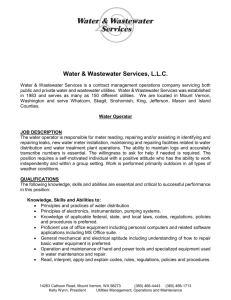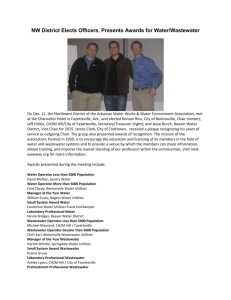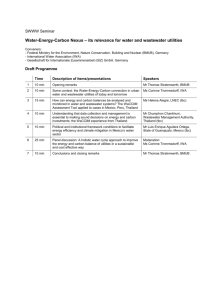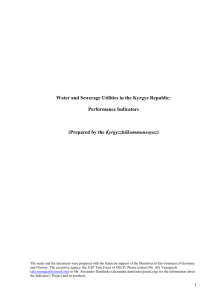1 - unece
advertisement
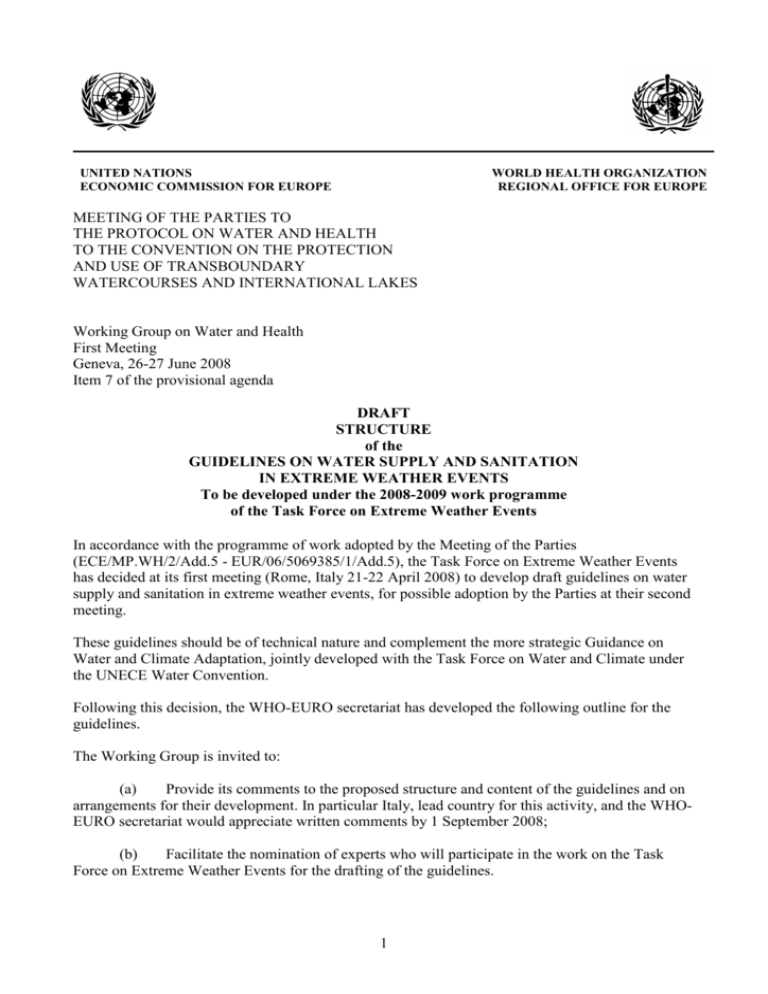
UNITED NATIONS ECONOMIC COMMISSION FOR EUROPE WORLD HEALTH ORGANIZATION REGIONAL OFFICE FOR EUROPE MEETING OF THE PARTIES TO THE PROTOCOL ON WATER AND HEALTH TO THE CONVENTION ON THE PROTECTION AND USE OF TRANSBOUNDARY WATERCOURSES AND INTERNATIONAL LAKES Working Group on Water and Health First Meeting Geneva, 26-27 June 2008 Item 7 of the provisional agenda DRAFT STRUCTURE of the GUIDELINES ON WATER SUPPLY AND SANITATION IN EXTREME WEATHER EVENTS To be developed under the 2008-2009 work programme of the Task Force on Extreme Weather Events In accordance with the programme of work adopted by the Meeting of the Parties (ECE/MP.WH/2/Add.5 - EUR/06/5069385/1/Add.5), the Task Force on Extreme Weather Events has decided at its first meeting (Rome, Italy 21-22 April 2008) to develop draft guidelines on water supply and sanitation in extreme weather events, for possible adoption by the Parties at their second meeting. These guidelines should be of technical nature and complement the more strategic Guidance on Water and Climate Adaptation, jointly developed with the Task Force on Water and Climate under the UNECE Water Convention. Following this decision, the WHO-EURO secretariat has developed the following outline for the guidelines. The Working Group is invited to: (a) Provide its comments to the proposed structure and content of the guidelines and on arrangements for their development. In particular Italy, lead country for this activity, and the WHOEURO secretariat would appreciate written comments by 1 September 2008; (b) Facilitate the nomination of experts who will participate in the work on the Task Force on Extreme Weather Events for the drafting of the guidelines. 1 Proposed outline of the guidelines on water supply and sanitation in extreme weather events 1. INTRODUCTION. 2. BASIC DISASTER PREPAREDNESS 2.1. TOOLS FOR DISASTER PLANNING (Meteorological forecasts, topographic information, GIS systems for vulnerability assessment…) 2.2. INTER-SECTORAL COOPERATION 2.2.1. Role of water utilities in disaster preparedness planning 2.2.2. Role of sewerage utilities in disaster preparedness planning 2.3. ROLE OF THE HEALTH SYSTEM IN DISASTER PREPAREDNESS 2.3.1. Assessing and climate proofing infrastructure 2.3.2. Logistic concerns: stockpiling vaccines and expendables 2.3.3. Human capacity building 3. PREPARATION: CLIMATE PROOFING OF UTILITIES. 3.1. RECALL OF CLIMATE CHANGE SCENARIOS 3.1.1. Current status of the region 3.1.2. Evolution of precipitation, droughts and floods in the European region 3.2. IMPACT ON THE WATER SUPPLY SECTOR 3.2.1. Case of centralized water supplies 3.2.2. Case of decentralized and community-based water supplies 3.3. IMPACT ON DRAINAGE, SEWERAGE AND WASTEWATER TREATMENT SYSTEMS 3.3.1. Case of centralized systems drainage, sewerage and wastewater treatment systems 3.3.2. Case of decentralized and community-based sanitation systems 3.4. SPECIFIC IMPACTS ON COASTAL AREAS 3.4.1. Saline water intrusion in aquifers used for the production of drinking-water 3.4.2. Quality changes in recreational waters 3.4.3. Quality changes in waters used for aquaculture and resulting food safety issues 3.4.4. Role of health systems 3.5. IMPACT ON HEALTH 3.5.1. Impact of heat waves and extended droughts 3.5.2. Impact of floods 3.5.3. Challenges of climate change to the health sector 2 4. ADAPTATION MEASURES FOR WATER UTILITIES 4.1. BASIC CONCEPTS OF RISK ASSESSMENT RISK MANAGEMENT (Adaptation of water safety plans (WSPs) to include climate change related risks) 4.2. RISKS RESULTING FROM WATER SCARCITY AND DROUGHT 4.2.1. Different risk elements 4.2.1.1.Physical safety of the installations 4.2.1.2.Hydraulic flow changes 4.2.1.3.Microbial pathogens 4.2.1.4.Chemical contamination 4.3. RISK RESULTING FROM EXTENDED RAIN PERIODS AND FLOODING 4.3.1. Risk elements from changes in precipitation and flow regimes 4.3.1.1.1. Physical safety of the installations 4.3.1.1.2. Hydraulic flow patterns 4.3.1.1.3. Microbial pathogens 4.3.1.1.4. Chemical contamination 4.4. ADAPTATION MEASURES DURING DROUGHTS 4.4.1. Measures to ensure continued operation of water supply utilities 4.4.1.1.Reservoir management 4.4.1.2.Operation of water supply utilities 4.4.1.2.1. Changes in SOP – increased use of disinfectants 4.4.1.3.Operation of drainage, sewerage and wastewater treatment utilities 4.4.2. Demand management 4.4.2.1.Water supply and sanitation utilities in management of transboundary water resources 4.4.2.2.Water supply and sanitation utilities in national water resource allocation 4.4.2.3.Reducing unaccounted-for water 4.4.2.4.Voluntary management of water demand 4.4.2.5.Mandatory management of water demand 4.4.2.6.Use of new water-resources 4.4.2.6.1. Promotion of the re-use of treated wastewater 4.4.2.6.2. Use of desalination techniques 4.5. ADAPTATION MEASURES DURING FLOODS 4.5.1. Continuity in the provision of safe drinking-water 4.5.2. Meeting drinking-water requirements in flooded areas 4.5.3. Meeting drinking-water requirements of displaced persons 4.5.4. Coping with hydraulic challenges 3 5. ADAPTATION MEASURES FOR DRAINAGE, SEWERAGE AND WASTEWATER TREATMENT UTILITIES 5.1. ADAPTATION MEASURES DURING DROUGHTS 5.1.1. Maintenance of the drainage and sewerage systems during periods of extended drought 5.1.2. Operation of wastewater treatment plants during periods of extended drought and changing hydraulic load 5.1.3. Operation of wastewater treatment plants during periods of extended drought and changing pollution load 5.2. ADAPTATION MEASURES DURING FLOODS 5.2.1. Operation of drainage and sewerage networks during periods of excessive rainfall 5.2.2. Operation of wastewater treatment plants during periods of extended rainfall and changing hydraulic load 5.2.3. Management of stormwater overflows 5.2.4. Management of stormwater holding tanks in wastewater treatment plants 5.2.5. Meeting hygiene requirements in flooded areas 5.2.6. Meeting hygiene requirements of displaced persons 6. MITIGATION MEASURES BY WATER SUPPLY UTILITIES 6.1. MITIGATING DROUGHT CONDITIONS 6.1.1. Adaptation measures to accept additional consumers from outside the service area on short notice. (Case of urban water utilities needing to suddenly service the needs of rural areas when the phreatic levels drop below the pumping level of shallow wells) 6.1.2. Adaptation measures to accept additional consumers (Case of drought and tourism management especially in the Mediterranean) 6.1.3. Ensuring reserve capacity through bulk transportation of water 6.1.3.1.1. Over-land transport 6.1.3.1.2. Over-sea transport 6.1.3.1.3. Management of water storage facilities 6.1.4. Ensuring reserve capacity through non-permanent water production capacity (desalination) 7. MITIGATION MEASURES FOR DRAINAGE, SEWERAGE AND WASTEWATER TREATMENT 7.1. MITIGATING DROUGHT CONDITIONS 7.1.1. Measures to ensure continued sanitation under drought conditions, particularly in non-centralized and community water supply. 4 7.2. MITIGATING FLOOD CONDITIONS 7.2.1. Management of hygiene requirements of population in flooded areas 7.2.2. Management of hygiene requirements of displaced populations in the event of flooding. 7.2.3. Management of drainage, sewerage and wastewater plants in flooded areas 8. RECOVERING DRINKING WATER SUPPLY 8.1. DROUGHT 8.1.1. Replenishment of reservoirs 8.2. FLOODING 8.2.1. Disinfecting and restarting flooded centralized production utilities (centralized) 8.2.2. Disinfecting and restarting flooded decentralized and community-based production utilities 8.2.3. Disinfecting and restarting flooded distribution networks 8.2.4. Disinfecting and restarting domestic networks (house connections and public buildings) 8.2.5. Decontaminating contaminated housing and public buildings 9. RECOVERING DRAINAGE, SEWERAGE AND WASTEWATER TREATMENT PLANS 9.1.1. Restoring and restarting drainage networks 9.1.1.1.Hydraulic considerations 9.1.1.2.Waste management issues 9.1.1.3.Occupational health issues 9.1.2. Restoring and reusing distribution networks 9.1.2.1.Hydraulic considerations 9.1.2.2.Waste management issues 9.1.2.3.Occupational health issues 9.1.3. Restarting wastewater treatment plants after flooding 9.1.4. Specific issue of industrial wastewater treatment plants 10. COMMUNICATION 10.1. IMPORTANCE OF A COMMUNICATION STRATEGY 10.2. COMMUNICATING AT DIFFERENT LEVELS – HOUSEHOLD, INDUSTRY, PUBLIC 10.3. COMMUNICATION TOOLS 5
